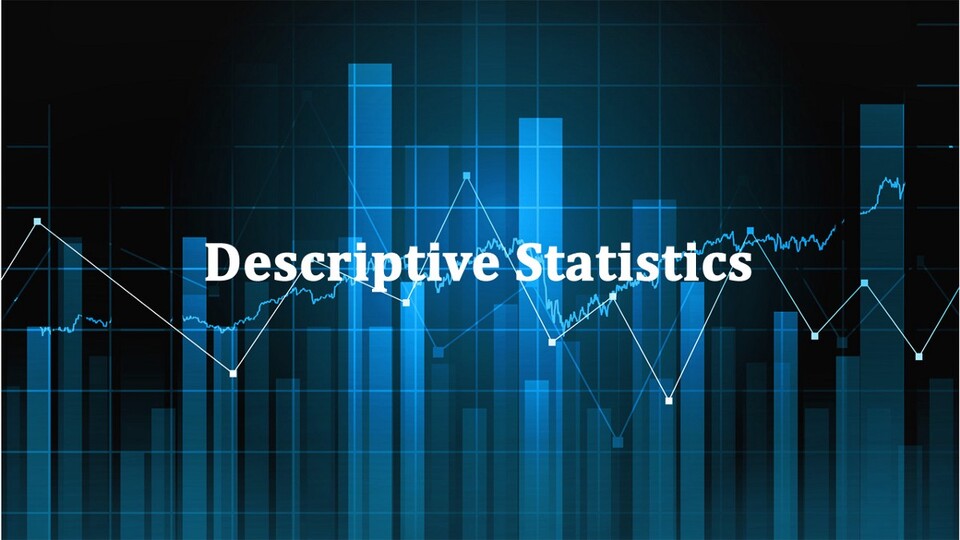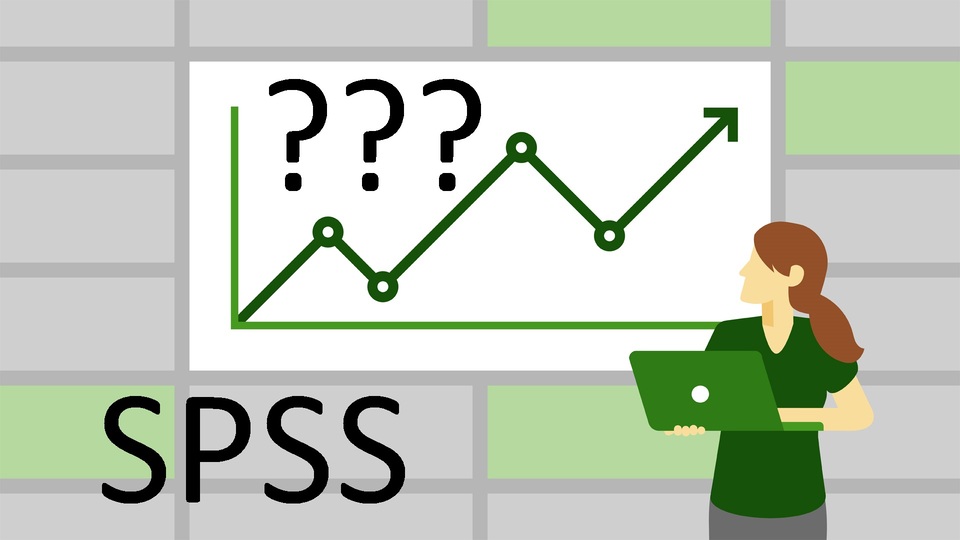Descriptive statistics on spss is a brief description of a large set of data or a set of methods used to facilitate the description of the main characteristics of the data quantitatively, using tables and charts to make it easier for the user to understand.
For example, the arithmetic mean provides information about the performance of the student and reflects the content of the big data, which contains the marks for each subject, to make it understandable to its reader without the need for knowledge of big data sets.
Moreover, descriptive statistics on spss are divided into two main sections, one section is concerned with measures of central tendency represented in the values of the arithmetic mean, median, and mode.
And another section of spss descriptive statistics is concerned with measures of dispersion such as standard deviation, variance, and maximum values, which indicate how the data is distributed by analyzing it and drawing a curve that includes all this data.
What descriptive statistics means?
Spss descriptive statistics is a set of methods concerned with collecting the vocabulary of the statistical study, and it is based on organizing and summarizing it.
After completing the summarization of this data, it is presented in a clear way, either in the form of tables or graphics and diagrams.
Through spss statistics tutor, it is possible to understand the nature of the research sample that was studied and tested.
Descriptive statistics on spss are usually relied upon when conducting experimental, field, and research studies.
Descriptive statistics on spss relies on two types of measures: Measures of Central Tendency, and Measures of Dispersion.
With regard to measures of central tendency, they are the mode, the arithmetic mean, and the median.
The measures of dispersion are the standard deviation and the range.
Spss statistics tutor depends on the presence of three main elements: the statistical population, the sample, and probability, in addition to the sampling unit.
What is the main purpose of descriptive statistics?
There is a range of purposes for spss descriptive statistics:
1- First: scientific research
Researchers in various scientific fields use spss statistics tutor to reach results and verify different hypotheses. For example, researchers use statistics to analyze data related to the production of viral vaccines to ensure consistency and safety.
It also depends on statistics in social sciences and applied research in varying proportions, which confirms the importance of statistical analysis in the field of Scientific Research.
2- Second: the commercial field
In the field of commerce and business administration, officials in companies use descriptive statistics on spss to improve understanding of the market and customer needs.
For example, telecommunications companies use statistics to improve their services and network resources and to reach a clear understanding of the needs of their customers.
3- Third: government institutions
Different governments rely on statistics, whether in the process of population census or in the economy and various administrative procedures.
4- Fourth: the commercial field
The stock market goes through great fluctuations, so companies usually use spss descriptive statistics to evaluate a number of their business decisions, including buying and selling shares.
In addition to relying on statistical analysis in the process of managing risks that the company may be exposed to and assessing the severity of these risks Finally.
Companies use regression equations to test general hypotheses related to the impact of a number of factors on the company\’s assets and the price of its shares on the stock exchange. Statistics are also used in other fields, including:
A- Market research
Where spss descriptive statistics are used in market research, it provides specific numbers about the supply and demand of products, the distribution of customers and their future directions, and others.
B- Business intelligence and data analysis
Descriptive statistics on spss is used in the field of business intelligence, as it provides a set of predictions that contribute to the development of future plans.
C- SEO
SEO relies on statistics as the main indicator, as it gives us the number of keywords that the audience is searching for online, which makes us target them.
D- Financial analysis
Technological development has increased the ability to retain and restore various data and is increasing the importance of statistics, as statistical computing becomes more important, including statistical programming and econometrics.
What are the 4 types of descriptive statistics?
Spss statistics tutor are statistical measures that deal with quantitative data, analyze and describe a group of statistical data, and are divided into four types: measures of central tendency, measures of dispersion, measures of correlation, and measures of distribution.
1- The measures of central tendency:
are measures that are used to obtain a single value to describe data, by determining the center of that data; This is why they are sometimes called measures of central location. There are three measures of central tendency as follows:
- The mean is calculated by taking the sum of the values of a variable and dividing it by the total number of values.
- The median is the average value of the variable.
- Mode The value that is repeated most often.
2- Measures of dispersion: these measures help in explaining the variation in the data, or in other words knowing the amount of homogeneous or heterogeneous data, and are divided into the following:
- The range is the difference between the largest and smallest value in the data.
- Variance is the mean squared deviation of the values in the data set from the mean.
- The coefficient of variation is the standard deviation divided by the mean.
- The range is the difference between the largest and smallest value in the data.
- The quartile and the interquartile skew are the values that divide the list of numbers into quadrants, and the quartile is half the distance between the first quartile and the third quartile.
- Mean and Mean Deviation The mean refers to the average of the values, while the mean deviation refers to the average of the absolute deviations of the values from their mean.
3- Frequency distribution measures: Frequency distribution measures are an overview of all the distinctive values in some variables, and the number of times they occur or recur, that is, the frequency distribution tells us how frequencies are distributed over the values.
And we often use frequency distributions to summarize categorical variables, And when we put the data in the form of a frequency polygon; It will give us a quick idea about the nature of the data distribution in terms of skewness and Kurtosis.
Among the characteristics of this scale are the following:
A- Skewness property The skewness property indicates the degree of divergence of the frequency curve from symmetry.
If most of the values are at the lower end of the distribution, and the closer we get to the higher end, the less the frequency of the values.
The data distribution, in this case, is described as skewed to negative skew, whereas if the opposite is skewed then it is described as skewed positive skewed.
B- The property of kurtosis: The property of kurtosis indicates the degree of concentration of frequencies in the middle region of the data, relative to the concentration at the two ends, compared to the standard normal distribution.
4- Measures of Association: Measures of Association are used when there is a relationship between two variables, and the two most popular measures are:
- Chi-square tests are used as a measure of the association between variables, in nominal data.
- Correlation coefficient The correlation coefficient is used to measure the strength of the relationship between numerical variables, and the Pearson coefficient is the most widely used correlation coefficient.
How can descriptive statistics be used to analyze data?
The descriptive statistics on spss are divided into five steps as follows:
- Description: The first step is to describe the data we want to analyze.
- Exploration: The second step is to discover the relationship of the data to the underlying content.
- Create a model: The third step is to create a model to show and understand the correlation of the data with the primary set.
- Model testing: The fourth step is based on testing the model with the aim of proving or disproving it.
- Predictive analytics: The fifth step is to use predictive analytics in order to activate scenarios, which will help in understanding future actions.
The following simplifies the steps of descriptive statistics on spss in another way:
1- Data collection:
The statistical analysis begins with collecting data, whether from primary or secondary sources.
For example, we can collect data through surveys, customer relationship management programs, financial reports, online tests, etc., by selecting a representative sample of the original community.
2- Data organization:
Now we have raw data and we want to organize it or, as statisticians call it, clean it, meaning to remove duplicate data and inconsistencies that may prevent us from obtaining an accurate analysis, and this step is very important because it helps us verify the validity of the data, and thus the validity of the conclusions that we draw from the analysis.
3- Display data:
After organizing the data comes the stage of presenting the data so that we can analyze it easily. In this step, we use descriptive statistics on spss tools to display the data correctly.
4- data analysis:
The fourth step of statistical analysis is data analysis. In this step, we use statistical techniques to explore relationships and trends. Here, we use deductive and correlational statistical analysis.
5- Data interpretation:
Now we have conducted the analysis and extracted the various correlations and trends within the data being analyzed. Here comes the interpretation stage after presenting the results in the form of charts, reports, etc.
There are also five common methods of spss descriptive statistics as follows:
1- First: the average
The mean is the simplest form of statistical analysis. It aims to determine the center point of a data set. It is calculated as follows:
Average = set of numbers ÷ number of items
Example: If we want to extract the average from the following numbers 1,2,3,4,5,6, we will add these numbers together, then divide it by a number of 6 numbers so that the average is 3.5
The average is characterized by being easy to calculate and helps in determining the general trend of the data.
As for its defects, it appears when the data subject to analysis contains a large number of outliers or a skewed distribution. In this case, the average does not provide the accuracy that we need to make the decision.
2- Second: the standard deviation
Standard deviation measures how spread the data is around the mean. A high standard deviation means that the data is widely dispersed from the mean.
While a low standard deviation is when most of the data is closer to the mean. One of its drawbacks is that just like the average it can give us inaccurate data.
Example of standard deviation: When conducting an opinion poll or questionnaire form towards a specific service or product, you can analyze the results of the respondents\’ answers.
And then measure the similarity or differences between the answers. If the similarity is significant, this means that the standard deviation is low and vice versa.
3- Third: decline
Regression is used to find the relationship between an independent variable and another dependent variable.
As it helps in tracking how the variables affect each other, and the regression shows the strength or weakness of the relationship between two variables and how it differs from one period to another.
4- Fourth: hypothesis testing
We use hypothesis testing when we want to make sure that a conclusion is valid for a specific data set by comparing the data with a certain assumption.
There may be a relationship between the variables or not at all, which is known as the null hypothesis.
Example: We can use hypothesis testing to find out the relationship between food type and health status or between academic achievement and advanced age, and the null hypothesis could be that there is no relationship between advanced age and academic achievement and so on.
5- Fifth: Determine the sample size
The indigenous population that we are conducting research on is usually very large and it is difficult to research all of its populations.
So we choose a representative sample of the original community and then generalize the results to it, and this is what we call determining the sample size.
And in order to do this correctly we need to determine the appropriate size of the sample to be representative of the original community and accurate.
And to achieve this we take samples because small samples may not be Expressive, as large samples, may be a waste of time, effort, and money.
From here stems the importance of samples in statistical analysis, as they are the decisive factor in the veracity and validity of the results or not.
In conclusion,
descriptive statistics on spss is one of the most widely used modern research methods, as we mentioned above, and spss descriptive statistics has many important uses in the field of scientific research.
Share via:


